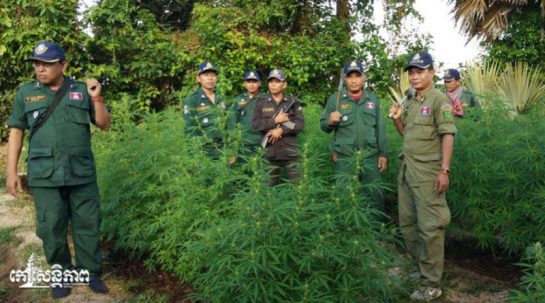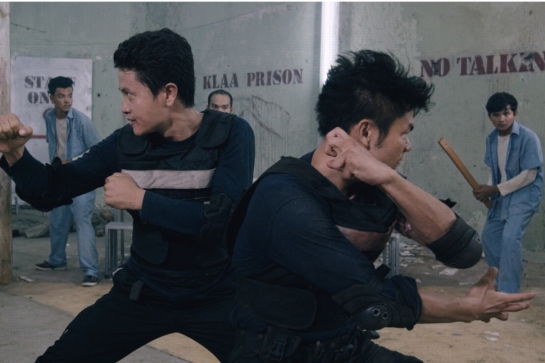
February – Police raid uncovers green harvest. Takeo province.
In my life I’ve visited jails only three times. Each time was to visit one or other friend who was serving time for marijuana possession. The crackdown on ganja continues and since 2017 almost 20,000 mostly young people have been imprisoned on similar charges – most to do with marijuana rather than harder drugs such as heroin. There are many facets to the story of cannabis in Cambodia.
One angle is the historic use of marijuana in Cambodia, mostly as a kind of chewing tobacco – I’ve been told how farmers would place some between their gum and their lip and would benefit from the stimulus. In cooking it was used as a herb.
But, despite one tourist blogger describing marijuana as ‘semi-legal’ for years it hasn’t actually been legal at all since 1961 (in line with an international treaty.) The law was first applied in 1992 when Cambodia was just opening up, but this remained mostly unenforced. For many years a blind eye was turned to casual usage.
In this context we see the rise of the backpacker trail and the rise of the “Happy Pizza” in Cambodia. By the early 2000s Happy Pizzas were served from small restaurants, many laced with cannabis, but others merely dining out on the reputation and allure of the real thing.
Backpacker word of mouth about leniency towards dope smoking soon spread. Word of mouth is powerful stuff, and it did not take long for Cambodia’s reputation to reach travellers who wanted a liberal place to visit.
To lift a few lines from the Cannabis Culture website:
Since Cambodia began opening up to tourists and foreign residents in 1992, this unique country has earned a stellar reputation for the availability, affordability and tolerance of marijuana. Grass is enjoyed openly in bars, restaurants and guesthouses all over Phnom Penh.
At a typical guesthouse you will almost always find community marijuana lying on the porch table. Scott, an English teacher living at a guesthouse, explains: “Marijuana is so cheap that it doesn’t make sense to be possessive. We just leave some on the table to save people the trouble of going to their rooms to get their stash.”
This reputation is still being pushed. A story on the fast growing and popular Culture Trip website goes under the headline: Why Phnom Penh, Cambodia is The New Marijuana Hotspot. That was published January 2018 – after the current crackdown had begun.
Or look up Trip Advisor. Says one tourist of a beach in Sihanoukville: “Beautiful beach and a paradise for weed smokers.”
The politics of marijuana are complex. Now it is being traded legally in many States of the USA, and now that possession is decriminalised is many nations, it is interesting that the Cambodian Government is meanwhile dialling up their war on drugs. They’re coming down hard on users, and further up the chain to the suppliers.
Example: recently I heard from a Cambodian, a non-user, who was picked up at a party along with 10 others; all young men. There had been dope smoked at the party, and back at the station, the policeman handling the case liberally used his baton – forcing confessions of usage or supply by cracking the skulls of the detainees. One guy after another. Even those who confessed got a baton slammed into the side of their skulls. A paradise for these weed smokers.
And in the news this last month – at least as reported by the Cambodia News English, major raids have resulted in significant plantations being destroyed by police.
Takeo province: According to a preliminary report, 1,398 ganja trees were torched on a 979 square meters plantation in Chroeung commune, Bakong commune, Kirivong district, Takeo province on February 17, 2019.
The green fingered horticulturalists had already fled by the time the cops arrived. They are now being hunted by law enforcement.
The Cambodian government, which is working with leaders in the six Mekong countries (Cambodia, China, Laos, Vietnam, Myanmar and Thailand) have agreed on a regional drug policy. So the recent war on drugs is not isolated to Cambodia.
There appears to be a concern amongst SE Asian governments that the real problem is not actually about marijuana, but about organised crime in general. As best as anyone can guess, there’s a link between the supply and distribution of weed in Cambodia and the supply and delivery of harder, more addictive drugs. Don’t confuse this with the “Gateway Drug” theory that posits that if you smoke dope, then you are more likely to try harder drugs. This has been debunked.
But at the supplier level there’s a nexus between dealing with soft drugs and harder stuff. The tuk tuk driver who offers you ganja is also in a position to offer something harder. Methamphetamine perhaps. That’s the bigger problem.
This report from the July 18th 2018 edition of This Week in Asia:
On New Year’s Day, [2018] Cambodian Prime Minister Hun Sen launched a six-month crackdown on the drug scourge that he said had become an increasing grievance for the country’s people. His announcement came shortly after a state visit by Philippine President Rodrigo Duterte, who in 2016 launched a violent anti-drugs campaign in his own country that went on to kill 7,000 people in seven months….Perhaps [it is] not surprising that Hun Sen, after the first spike in detentions in February, rushed to assure Cambodians that his campaign would not be bloody.
Doubts about the true effectiveness of the crackdown have been voiced widely. On the one hand the high number of arrests has placed a strain on the prison system. On the other hand there are fears that the crackdown might potentially facilitate more police corruption. And who pays for all of this?
Well, there have been serious suggestions that drug suspects should have their possessions sold by the state to fund more rehab centres. Users pay? Though remember, you go to jail as a suspect – and have yet to be proven guilty. Human Rights representatives have voiced concern about the plan.
It saddens me that so many young people have been swept up in police raids, and equally it bothers me that non-Cambodians are still talking of Cambodia as a drug paradise. Those tuk-tuk drivers who offer you ganja, or something harder – are kept in business by tourists – and it is seldom the foreigners who pay the price. That said, in April last year the Australian owner of the Soul Train Reggae Bar was arrested for possession and she faces years in prison.
Personally I’m not interested in cannabis, I tried to inhale once, as a student, but the spliff that got passed to me was too soggy to inhale anything. So I’m a Bill-(But I didn’t inhale)-Clinton-in-reverse on this one. I tried to inhale.
But it bothers me that perhaps through the interaction with the west, what had once been a simple herb has now become a black market business. Where there’s money in something illegal then you get corruption, crime, and – ultimately – people who lose everything.
We can argue the merits of decriminalisation, (I’m all for it) rehabilitation (essential!), and whether or not cannabis is actually harmless (I personally think it is harmful to functions such as memory,) but park that to one side.
In the given situation of Cambodia today, I don’t see how cannabis usage by anyone is doing anything other than fuel a problem. What do you think?
Click here for an account of one of my prison visits. – what was it like? Actually very moving.
Your comments and feedback are welcome. Write me a note!





You must be logged in to post a comment.